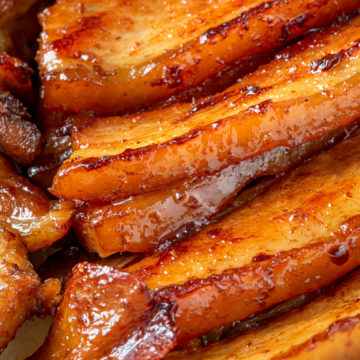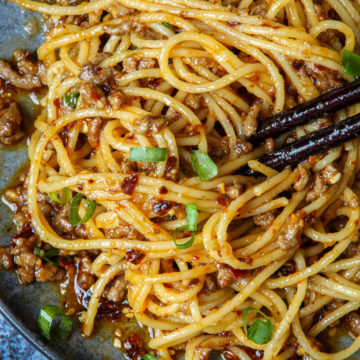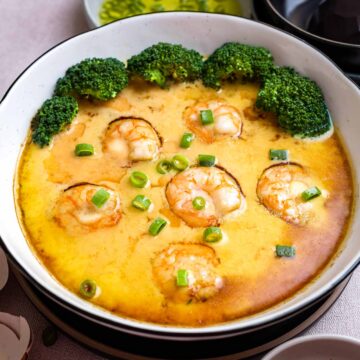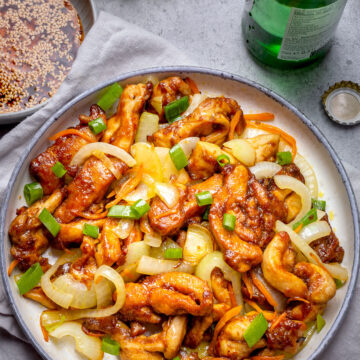I’m visiting family in my hometown, Xiamen, in southern China. It’s a beautiful place, and we’ve got some amazing food here!
I’m super excited to show off some yummy food that you can only find in Fujian province, and some dishes are so local, you can only get them in Xiamen.
So, come along, and let’s explore the tasty dishes that make my hometown so special!

Food in Xiamen
Satay Noodles(沙茶面)


If you were to ask me what the most unique dish in Xiamen, something you can’t find anywhere else in China, I’d definitely say it’s the Satay noodles.
It’s like a signature dish of the city, available in every corner. It’s the food I crave most and must have on my list every time I visit family in Xiamen.
It’s hard to trace its exact origins, but it’s believed to have been created by a Chinese person returning from South Asia, where satay is commonly used. Over time, it evolved with some unique twists to suit local tastes.
What ingredients are used in this satay noodles?
Recreating this dish at home isn’t easy. The soup base is incredibly complex, made with pork bone and shrimp stock, satay paste, peanut paste, and many other undisclosed ingredients that stores keep as business secrets.
The noodles and toppings are simply boiled in hot water and then added to the satay soup.
Since every store has its own unique soup ingredients, the most successful ones have people lining up for this satay noodles all day long. There’s always discussion about which store serves the best satay noodles.
Cost
The satay noodles with pork and shrimp topping are priced at $3 USD
Beef Soup(牛肉羹)


This beef soup has a history spanning a few hundred years and is widely enjoyed in Fujian province, originating from the city of Quanzhou.
How to make this beef soup
The beef is thinly sliced and then mixed with seasoning and sweet potato powder. This mixture is hand-mixed to blend all the ingredients together, a process that can take up to 1 or 2 hours, making it a very labor-intensive dish.
The beef tastes incredibly tender and silky because the sweet potato powder not only blends seamlessly with the meat but also helps lock in moisture, ensuring each bite is tender and flavourful.
The broth is made from beef bones and Chinese herbs, resulting in a rich and flavourful taste.
Cost
A medium-sized soup costs $3 (USD).
Hand Pulled Beef Noodles (兰州牛肉拌面)


If you’re a fan of Chinese noodles, you’ve probably heard of Lanzhou hand-pulled noodles. They’re incredibly popular and you can find stores selling them in almost every city in China.
In the 1980s, when Lanzhou hand-pulled noodles opened their first shop in Xiamen, they discovered that hot noodle soup wasn’t popular during the summer. To cater to local tastes, they invented a beef meat sauce to pour over the hand-pulled noodles, which became the most popular choice over the years.
I have tried to find this particular meat sauce hand-pulled noodles elsewhere, but it seems it is very particular to Xiamen.
The dish tastes delicious when served with Chinese black vinegar and chili oil.
I’ve created my own version using angel hair pasta, which has a similar texture to hand-pulled noodles. You can find the recipe here.
Cost
A medium-sized portion of the noodle dish is priced at around $3 USD.
Sticky Rice Dumpling(肉粽)

The sticky rice dumpling (Zongzi) is a traditional Chinese dish made of glutinous rice filled with various ingredients and wrapped in bamboo leaves.
In Fujian province, the sticky rice is seasoned with soy sauce and five spice powder. The filling usually includes ingredients like pork belly, shiitake mushrooms, chestnuts, dried shrimp, and more.
The ingredients are wrapped in bamboo leaves and slow-cooked until they meld together, resulting in this incredibly delicious dish.
I’ve recreated this dish in my kitchen, skipping the leaf wrapping, and it tastes similar to the original version.
Cost
One sticky rice dumpling costs $2 USD. I usually need two of these for one meal.
Silkie Thin Noodle Soup (乌绒鸡面线)


My mom always makes me this silkie chicken noodle soup as soon as I get home after a long flight. It’s like the ultimate comfort food for me. This food represents home in my heart.
Silkie – Oolong Chicken
The Silkie, also known as oolong chicken locally, is hands down the best chicken I’ve ever eaten. Its meat is incredibly silky and tender, with a flavour that beats any chicken you can buy at the supermarket.
Sure, its black skin and bones might seem a little off-putting at first, but once you taste the soup, you’ll understand what I mean.
It’s simply cooked with just a few slices of ginger and a pinch of salt – that’s all you need.
Thin Noodles
The thin noodles are crafted from flour, water, and salt, delicately hand-pulled until they’re as thin as hair, and then left to air dry.
They’re a special type of noodles commonly found in Fujian province, symbolising longevity and good luck.
How to make this Silkie noodle soup
The noodles are boiled in hot water and then added to the chicken soup. It’s a very simple but classic local noodle dish.
Cost:
- Silkie chicken: $5(USD) per kilogram. The whole silkie, weighing about 1.5 kilograms, costs $7.50.
- Thin noodles: $3 (USD) per Kilogram
Oyster Omelette (海蛎煎)

If you visit Fujian province, you’ll discover that this oyster omelette dish is very popular, especially in Xiamen. There are plenty of oyster farms along the coastal cities, making oysters cheap enough for daily consumption.
The oysters are combined with sweet potato powder and local baby leeks or coriander, then pan-fried and topped with egg. It’s served with the local garlic chili sauce, making it a beloved dish enjoyed by many locals.
The recipe is here if you can source fresh oysters and want to give it a try.
Cost
The oysters cost $8 USD per kilogram. Ordering them from local eateries costs about $4 USD per serving.





